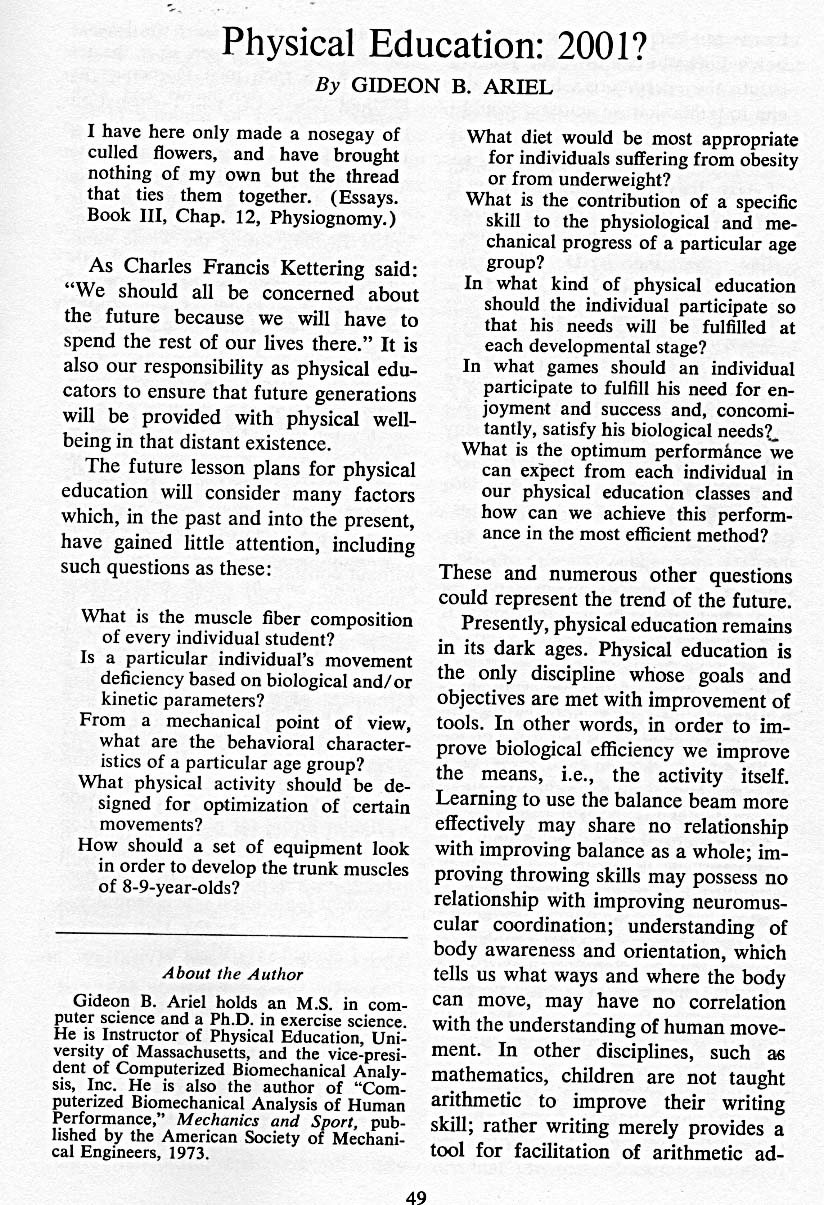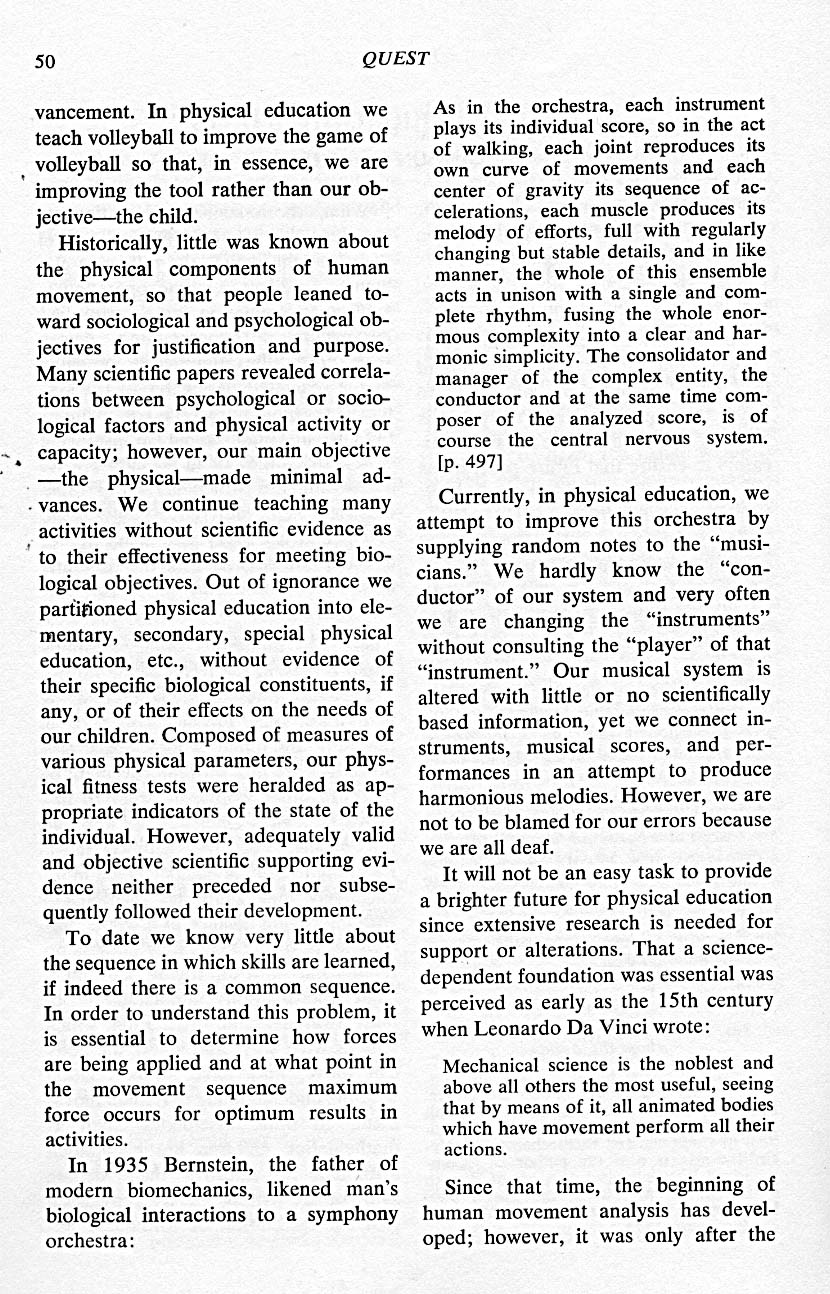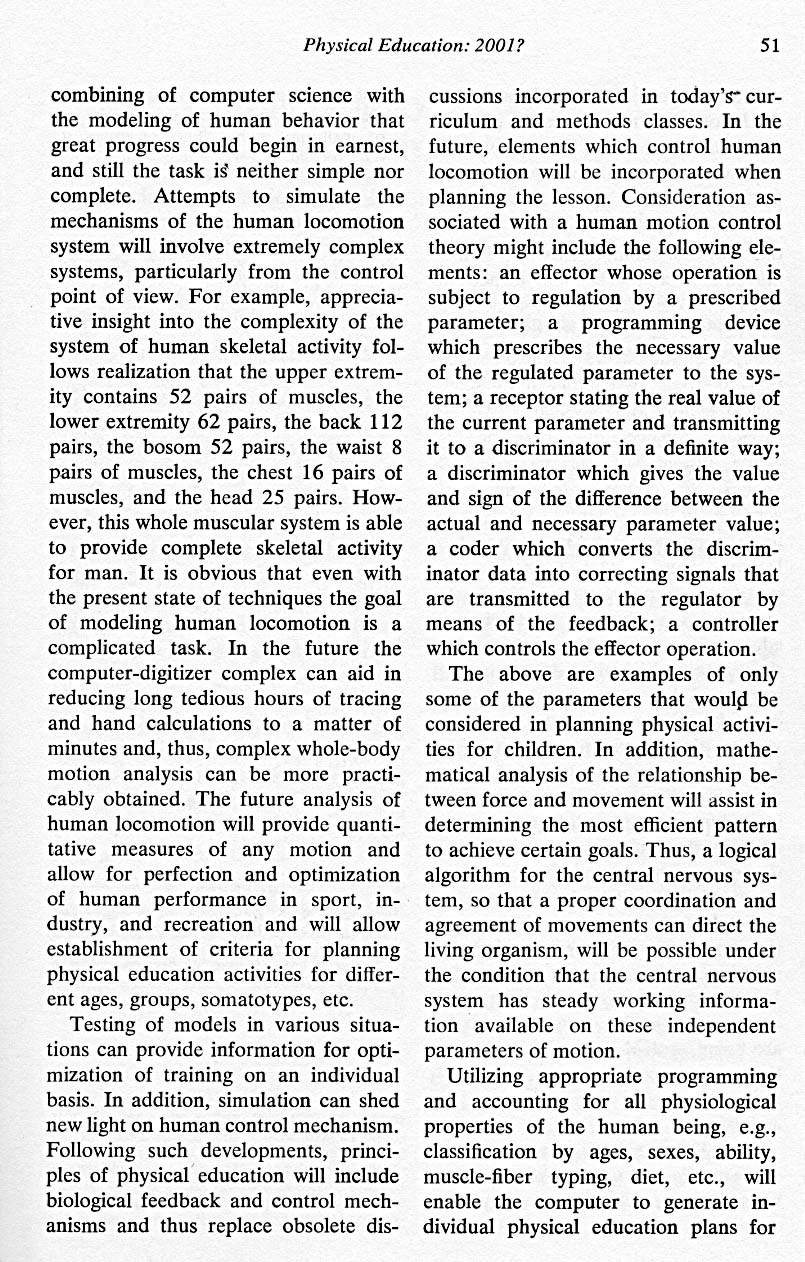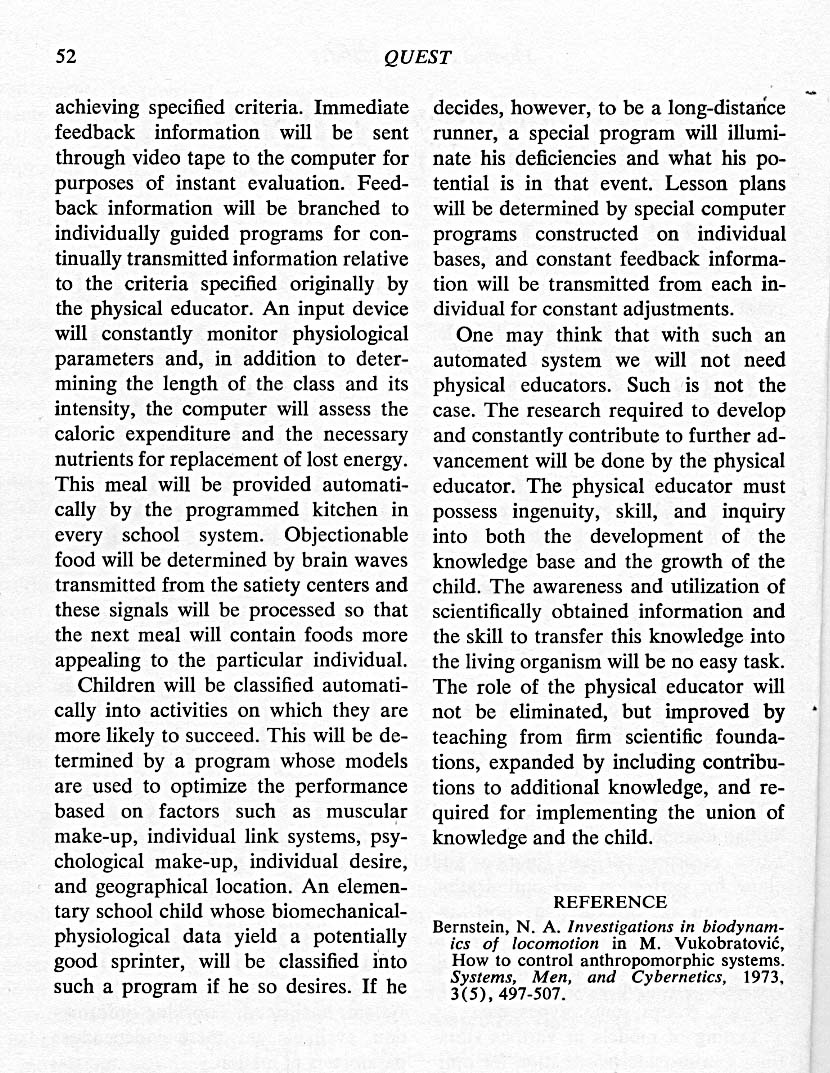Physical Education: 2001?
"We should all be concerned about the future because we will have to spend the rest of our lives there."
By Gideon Ariel in QUEST on Tuesday, January 1, 1974
Synopsis
The article "Physical Education: 2001?" by Gideon B. Ariel discusses the future of physical education and the need for a more scientific approach. Ariel argues that physical education is currently in its "dark ages", with many activities taught without scientific evidence of their effectiveness. He suggests that future lesson plans should consider factors such as muscle fiber composition, movement deficiency, and the behavioral characteristics of different age groups. Ariel also highlights the potential of computer science in modeling human behavior and optimizing physical education plans. He envisions a future where computers generate individual physical education plans, monitor physiological parameters, and provide immediate feedback. Despite the automation, Ariel asserts that the role of the physical educator will not be eliminated but improved, as they will be required to implement the union of knowledge and the child.
Tip: use the left and right arrow keys
QUEST
FOR TOMORROW
� THE NATIONAL ASSOCIATION FOR PHYSICAL EDUCATION OF COLLEGE WOMEN
� THE NATIONAL COLLEGE PHYSICAL EDUCATION ASSOCIATION FOR MEN
Physical Education: 2001?
By GIDEON B. ARIEL
I have here only made a nosegay of culled flowers, and have brought nothing of my own but the thread that tics them together. (Essays. Book III, Chap. 12, Physiognomy.)
As Charles Francis Kettering said: "We should all be concerned about
the future because we will have to spend the rest of our lives there." It is also our responsibility as physical edu
cators to ensure that future generations will be provided with physical wellbeing in that distant existence.
The future lesson plans for physical education will consider many factors which, in the past and into the present, have gained little attention, including such questions as these:
What is the muscle fiber composition of every individual student?
Is a particular individual's movement deficiency based on biological and/or kinetic parameters?
From a mechanical point of view, what are the behavioral characteristics of a particular age group?
What physical activity should be designed for optimization of certain movements?
How should a set of equipment look in order to develop the trunk muscles of 8-9-year-olds?
About the Author
Gideon B. Ariel holds an M.S. in computer science and a Ph.D. in exercise science. He is Instructor of Physical Education, University of Massachusetts, and the vice-president of Computerized Biomechanical Analysis, Inc. He is also the author of "Computerized Biomechanical Analysis of Human Performance," Mechanics and Sport, published by the American Society of Mechanical Engineers, 1973.
What diet would be most appropriate for individuals suffering from obesity
or from underweight?
What is the contribution of a specific
skill to the physiological and mechanical progress of a particular age
group?
In what kind of physical education should the individual participate so that his needs will be fulfilled at each developmental stage?
In what games should an individual participate to fulfill his need for en
joyment and success and, concomitantly, satisfy his biological needs?
What is the optimum performance we can expect from each individual in
our physical education classes and how can we achieve this perform
ance in the most efficient method?
These and numerous other questions could represent the trend of the future.
Presently, physical education remains in its dark ages. Physical education is the only discipline whose goals and objectives are met with improvement of tools. In other words, in order to improve biological efficiency we improve the means, i.e., the activity itself. Learning to use the balance beam more effectively may share no relationship with improving balance as a whole; improving throwing skills may possess no relationship with improving neuromuscular coordination; understanding of body awareness and orientation, which tells us what ways and where the body can move, may have no correlation with the understanding of human movement. In other disciplines, such as mathematics, children are not taught arithmetic to improve their writing skill; rather writing merely provides a tool for facilitation of arithmetic ad-
49
50
QUEST
vancement. In physical education we teach volleyball to improve the game of volleyball so that, in essence, we are improving the tool rather than our objective-the child.
Historically, little was known about the physical components of human movement, so that people leaned toward sociological and psychological objectives for justification and purpose. Many scientific papers revealed correlations between psychological or sociological factors and physical activity or capacity; however, our main objective -the physical-made minimal advances. We continue teaching many activities without scientific evidence as to their effectiveness for meeting biological objectives. Out of ignorance we partitioned physical education into elementary, secondary, special physical education, etc., without evidence of their specific biological constituents, if any, or of their effects on the needs of our children. Composed of measures of various physical parameters, our physical fitness tests were heralded as appropriate indicators of the state of the individual. However, adequately valid and objective scientific supporting evidence neither preceded nor subsequently followed their development.
To date we know very little about the sequence in which skills are learned, if indeed there is a common sequence. In order to understand this problem, it is essential to determine how forces are being applied and at what point in the movement sequence maximum force occurs for optimum results in activities.
In 1935 Bernstein, the father of modern biomechanics, likened man's biological interactions to a symphony orchestra:
As in the orchestra, each instrument plays its individual score, so in the act of walking, each joint reproduces its own curve of movements and each center of gravity its sequence of accelerations, each muscle produces its melody of efforts, full with regularly changing but stable details, and in like manner, the whole of this ensemble acts in unison with a single and complete rhythm, fusing the whole enormous complexity into a clear and harmonic simplicity. The consolidator and manager of the complex entity, the conductor and at the same time composer of the analyzed score, is of course the central nervous system. [p. 497]
Currently, in physical education, we attempt to improve this orchestra by supplying random notes to the "musicians." We hardly know the "con
ductor" of our system and very often we are changing the "instruments"
without consulting the "player" of that "instrument." Our musical system is
altered with little or no scientifically based information, yet we connect in
struments, musical scores, and performances in an attempt to produce harmonious melodies. However, we are not to be blamed for our errors because we are all deaf.
It will not be an easy task to provide
a brighter future for physical education since extensive research is needed for
support or alterations. That a sciencedependent foundation was essential was perceived as early as the 15th century when Leonardo Da Vinci wrote:
Mechanical science is the noblest and above all others the most useful, seeing that by means of it, all animated bodies which have movement perform all their
actions.
Since that time, the beginning of human movement analysis has developed; however, it was only after the
Physical Education: 2001?
51
combining of computer science with the modeling of human behavior that great progress could begin in earnest, and still the task is neither simple nor complete. Attempts to simulate the mechanisms of the human locomotion system will involve extremely complex systems, particularly from the control point of view. For example, appreciative insight into the complexity of the system of human skeletal activity follows realization that the upper extremity contains 52 pairs of muscles, the lower extremity 62 pairs, the back 112 pairs, the bosom 52 pairs, the waist 8 pairs of muscles, the chest 16 pairs of muscles, and the head 25 pairs. However, this whole muscular system is able to provide complete skeletal activity for man. It is obvious that even with the present state of techniques the goal of modeling human locomotion is a complicated task. In the future the computer-digitizer complex can aid in reducing long tedious hours of tracing and hand calculations to a matter of minutes and, thus, complex whole-body motion analysis can be more practicably obtained. The future analysis of human locomotion will provide quantitative measures of any motion and allow for perfection and optimization of human performance in sport, industry, and recreation and will allow establishment of criteria for planning physical education activities for different ages, groups, somatotypes, etc.
Testing of models in various situations can provide information for optimization of training on an individual basis. In addition, simulation can shed new light on human control mechanism. Following such developments, principles of physical education will include biological feedback and control mechanisms and thus replace obsolete dis
cussions incorporated in today's' curriculum and methods classes. In the future, elements which control human locomotion will be incorporated when planning the lesson. Consideration associated with a human motion control theory might include the following elements: an effector whose operation is subject to regulation by a prescribed parameter; a programming device which prescribes the necessary value of the regulated parameter to the system; a receptor stating the real value of the current parameter and transmitting it to a discriminator in a definite way; a discriminator which gives the value and sign of the difference between the actual and necessary parameter value; a coder which converts the discriminator data into correcting signals that are transmitted to the regulator by means of the feedback; a controller which controls the effector operation.
The above are examples of only some of the parameters that woulfi be considered in planning physical activities for children. In addition, mathematical analysis of the relationship between force and movement will assist in determining the most efficient pattern to achieve certain goals. Thus, a logical algorithm for the central nervous system, so that a proper coordination and agreement of movements can direct the living organism, will be possible under the condition that the central nervous system has steady working information available on these independent parameters of motion.
Utilizing appropriate programming and accounting for all physiological properties of the human being, e.g., classification by ages, sexes, ability, muscle-fiber typing, diet, etc., will enable the computer to generate individual physical education plans for
52
QUEST
achieving specified criteria. Immediate feedback information will be sent through video tape to the computer for purposes of instant evaluation. Feedback information will be branched to individually guided programs for continually transmitted information relative to the criteria specified originally by the physical educator. An input device will constantly monitor physiological parameters and, in addition to determining the length of the class and its intensity, the computer will assess the caloric expenditure and the necessary nutrients for replacement of lost energy. This meal will be provided automatically by the programmed kitchen in every school system. Objectionable food will be determined by brain waves transmitted from the satiety centers and these signals will be processed so that the next meal will contain foods more appealing to the particular individual.
Children will be classified automatically into activities on which they are more likely to succeed. This will be determined by a program whose models are used to optimize the performance based on factors such as muscular make-up, individual link systems, psychological make-up, individual desire, and geographical location. An elementary school child whose biomechanicalphysiological data yield a potentially good sprinter, will be classified into such a program if he so desires. If he
decides, however, to be a long-distance runner, a special program will illuminate his deficiencies and what his potential is in that event. Lesson plans will be determined by special computer programs constructed on individual bases, and constant feedback information will be transmitted from each individual for constant adjustments.
One may think that with such an automated system we will not need physical educators. Such is not the case. The research required to develop and constantly contribute to further advancement will be done by the physical educator. The physical educator must possess ingenuity, skill, and inquiry into both the development of the knowledge base and the growth of the child. The awareness and utilization of scientifically obtained information and the skill to transfer this knowledge into the living organism will be no easy task. The role of the physical educator will not be eliminated, but improved by teaching from firm scientific foundations, expanded by including contributions to additional knowledge, and required for implementing the union of knowledge and the child.
REFERENCE
Bernstein, N. A. Investigations in biodynamics of locomotion in M. Vukobratovic, How to control anthropomorphic systems. Systems, Men, and Cybernetics, 1973. 3(5),497-507.





